Christopher alexander - A pattern language
Здесь есть возможность читать онлайн «Christopher alexander - A pattern language» весь текст электронной книги совершенно бесплатно (целиком полную версию без сокращений). В некоторых случаях можно слушать аудио, скачать через торрент в формате fb2 и присутствует краткое содержание. Жанр: Прочая научная литература, на английском языке. Описание произведения, (предисловие) а так же отзывы посетителей доступны на портале библиотеки ЛибКат.
- Название:A pattern language
- Автор:
- Жанр:
- Год:неизвестен
- ISBN:нет данных
- Рейтинг книги:3 / 5. Голосов: 1
-
Избранное:Добавить в избранное
- Отзывы:
-
Ваша оценка:
- 60
- 1
- 2
- 3
- 4
- 5
A pattern language: краткое содержание, описание и аннотация
Предлагаем к чтению аннотацию, описание, краткое содержание или предисловие (зависит от того, что написал сам автор книги «A pattern language»). Если вы не нашли необходимую информацию о книге — напишите в комментариях, мы постараемся отыскать её.
A pattern language — читать онлайн бесплатно полную книгу (весь текст) целиком
Ниже представлен текст книги, разбитый по страницам. Система сохранения места последней прочитанной страницы, позволяет с удобством читать онлайн бесплатно книгу «A pattern language», без необходимости каждый раз заново искать на чём Вы остановились. Поставьте закладку, и сможете в любой момент перейти на страницу, на которой закончили чтение.
Интервал:
Закладка:
 |
| Two orthogonal networks. |
In practice, there are several possible ways of forming this relationship between the roads and paths.
It can be done within the system of fast one-way roads about 300 feet apart described in parallel roads(23). Between the roads there are pedestrian paths running at right angles to the roads, with buildings opening off the pedestrian paths. Where the
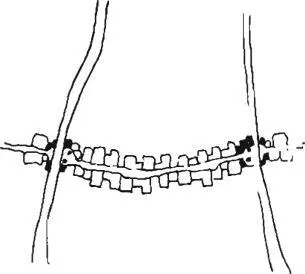 |
| Path between farallel roads. |
I'll 5 2 NETWORK OF PATHS AND CARS
paths intersect the roads there are small parking lots with space for kiosks and shops.
It can be applied to an existing neighborhood—as it is in the following sequence of plans drawn by the People’s Architects, Berkeley, California. This shows a beautiful and simple way of creating a path network in an existing grid of streets, by closing off alternate streets, in each direction. As the drawings show, it can be done gradually.
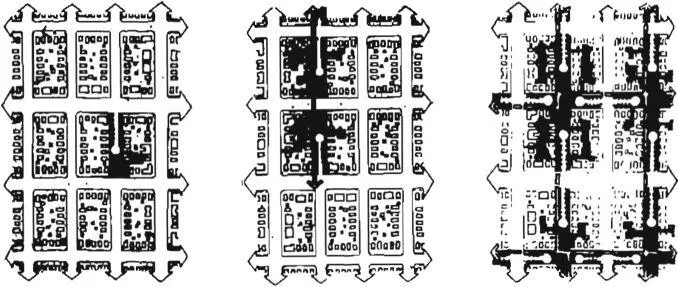 |
| The growth of a fath network in a street grid.. |
Different again, is our project for housing in Lima. Here the two orthogonal systems are laid out as follows:
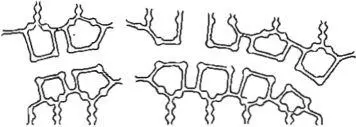 |
Roads. |
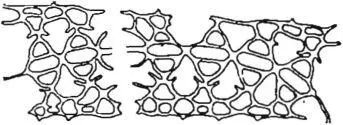 |
Pedestrian falhs. |
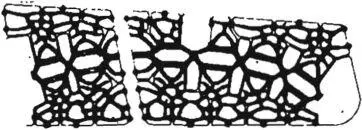 |
The two together. |
In all these cases, we see a global pattern, in which roads and paths are created more or less at the same time—and therefore brought into the proper relationship. However, it is essential to recognize that in most practical applications of this pattern, it is
273
not necessary to locate the roads and paths together. Most typically of all, there is an existing road system: and the paths can be put in one by one, piecemeal, at right angles to the existing roads. Slowly, very slowly, a coherent path network will be created by the accumulation of these piecemeal acts.
Finally, note that this kind of separation of cars from pedestrians is only appropriate where traffic densities are medium or medium high. At low densities (for instance, a cul-de-sac gravel road serving half-a-dozen houses), the paths and roads can obviously be combined. There is no reason even to have sidewalks— green streets(51). At very high densities, like the Champs Elysees, or Piccadilly Circus, a great deal of the excitement is actually created by the fact that pedestrian paths are running along the roads. In these cases the problem is best solved by extra wide sidewalks— raised walks(55)—which actually contain the resolution of the conflict in their width. The edge away from the road is safe—the edge near the road is the place where the activities happen.
Therefore:
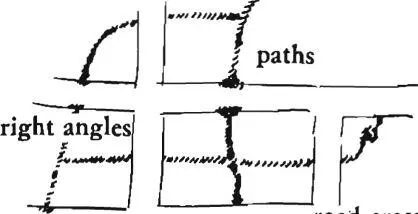 |
| road crossings |

Except where traffic densities are very high or very low, lay out pedestrian paths at right angles to roads, not along them, so that the paths gradually begin to form a second network, distinct from the road system, and orthogonal to it. This can be done quite gradually—even if you put in one path at a time, but always put them in the middle of the “block,” so that they run across the roads.
52 NETWORK OF PATHS AND CARS
•I* *r ‘I*
Where paths have to run along major roads—as they do occasionally—build them 18 inches higher than the road, on one side of the road only, and twice the usual width—raised walk (55) ; on creen streets (51) the paths can be in the road since there is nothing but grass and paving stones there; but even then, occasional narrow paths at right angles to the green streets are very beautiful. Place the paths in detail according to paths and coals (120); shape them according to path shape (121). Finally, treat the important street crossings as crosswalks, raised to the level of the pedestrian path—so cars have to slow down as they go over them—road crossing (54). . . .
make a buildable building directly from this rough scheme of spaces, and tells you how to build it, in detail.
Before you lay out structural details, establish a philosophy of structure which will let the structure grow directly from your plans and your conception of the buildings 3
205 . STRUCTURE FOLLOWS SOCIAL SPACES
206. EFFICIENT STRUCTURE
207. GOOD MATERIALS
208. GRADUAL STIFFENING
within this philosophy of structure, on the basis of the plans which you have made, work out the complete structural layout 3 this is the last thing you do on paper, before you actually start to build 3
209 . ROOF LAYOUT
210. FLOOR AND CEILING LAYOUT
21 I. THICKENING THE OUTER WALLS
212. COLUMNS AT THE CORNERS
213 . FINAL COLUMN DISTRIBUTION
put stakes in the ground to mark the columns on the site, and start erecting the main frame of the building according to the layout of these stakes 3
214 . ROOT FOUNDATIONS
215 . GROUND FLOOR SLAB
216. BOX COLUMNS
xxxi 1
| 53 main gateways** |
|---|
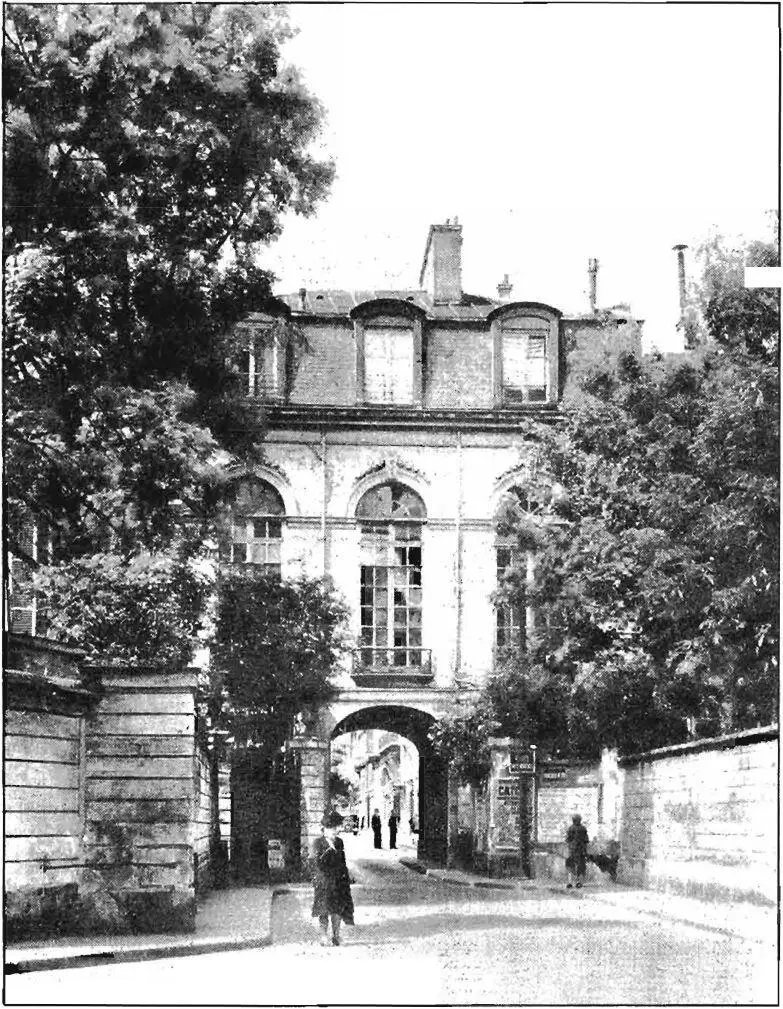 |
276
. . . at various levels in the structure of the town, there are identifiable units. There are neighborhoods—identifiable neighborhood (14), clusters—house cluster (37), communities of work—work community (41) ; and there are many smaller building complexes ringed around some realms of circulation—building complex (95), circulation realms (98). All of them get their identity most clearly from the fact that you pass through a definite gateway to enter them—it is this gateway acting as a threshold which creates the unit.
Any part of a town—large or small—which is to be identified by its inhabitants as a precinct of some kind, will be reinforced, helped in its distinctness, marked, and made more vivid, if the paths which enter it are marked by gateways where they cross the boundary.
Many parts of a town have boundaries drawn around them. These boundaries are usually in people’s minds. They mark the end of one kind of activity, one kind of place, and the beginning of another. In many cases, the activities themselves are made more sharp, more vivid, more alive, if the boundary which exists in people’s minds is also present physically in the world.
Читать дальшеИнтервал:
Закладка:
Похожие книги на «A pattern language»
Представляем Вашему вниманию похожие книги на «A pattern language» списком для выбора. Мы отобрали схожую по названию и смыслу литературу в надежде предоставить читателям больше вариантов отыскать новые, интересные, ещё непрочитанные произведения.
Обсуждение, отзывы о книге «A pattern language» и просто собственные мнения читателей. Оставьте ваши комментарии, напишите, что Вы думаете о произведении, его смысле или главных героях. Укажите что конкретно понравилось, а что нет, и почему Вы так считаете.












